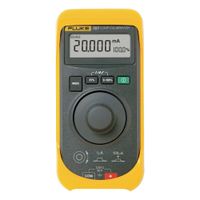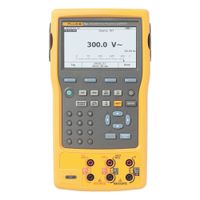Call +(254) 703 030 000 / 751 483 999 / 721 704 777
- Home
- Test Instruments
- Process Pressure Calibration
- Calibrators Accessories
.....Read More
Frequently Asked Questions
What is a process calibrator and how does it work?
A process calibrator is a precision instrument used to test and calibrate various process parameters such as temperature, pressure, electrical signals, and frequency in industrial settings. It ensures that instruments and sensors used in process control systems are accurate and functioning correctly, which is crucial for maintaining product quality, safety, and efficiency.
Process calibrators work by simulating the input signals that a process instrument would typically measure. For example, a temperature calibrator can simulate thermocouple or RTD signals, while a pressure calibrator can generate specific pressure levels. Electrical calibrators can simulate current, voltage, and resistance signals. By comparing the output of the process instrument with the known input from the calibrator, technicians can determine if the instrument is accurate or needs adjustment.
The calibration process typically involves connecting the calibrator to the instrument under test, setting the desired input signal on the calibrator, and then reading the output from the instrument. If the instrument's output deviates from the expected value, adjustments are made to bring it within acceptable limits. This process may involve zeroing, spanning, or linearizing the instrument's response.
Advanced process calibrators often include features like data logging, automated calibration procedures, and communication interfaces for integration with calibration management software. These features enhance efficiency and accuracy, allowing for comprehensive documentation and traceability of calibration activities.
Overall, process calibrators are essential tools in industries such as manufacturing, oil and gas, pharmaceuticals, and utilities, where precise control of process variables is critical.
What are the different types of process calibrators available?
Process calibrators are essential tools used to verify and adjust the accuracy of various process instruments. The different types of process calibrators include:
1. **Temperature Calibrators**: These are used to calibrate temperature sensors like thermocouples and RTDs. They include dry-block calibrators, which provide a stable temperature source, and liquid bath calibrators, which offer uniform temperature distribution.
2. **Pressure Calibrators**: These devices calibrate pressure sensors and gauges. They can be handheld or benchtop models and often include a pressure source and a digital readout. Some models can simulate pressure electronically.
3. **Multifunction Calibrators**: These versatile devices can calibrate multiple parameters, including voltage, current, resistance, temperature, and frequency. They are ideal for technicians who need to calibrate various instruments.
4. **Loop Calibrators**: Specifically designed for 4-20 mA current loops, these calibrators can source and measure current, making them essential for calibrating transmitters and control systems.
5. **Voltage and Current Calibrators**: These are used to calibrate devices that measure electrical signals. They can source and measure DC voltage and current, ensuring the accuracy of multimeters and other electrical instruments.
6. **Frequency Calibrators**: These calibrators are used to verify the accuracy of devices that measure frequency, such as tachometers and frequency counters.
7. **pH Calibrators**: Used to calibrate pH meters, these devices ensure accurate pH measurements in various applications, from laboratory analysis to industrial processes.
8. **Field Calibrators**: Portable and rugged, these calibrators are designed for on-site calibration in challenging environments. They often combine multiple functions to handle various calibration tasks in the field.
Each type of calibrator is designed to meet specific calibration needs, ensuring the accuracy and reliability of process instruments across different industries.
How do I choose the right calibrator for my application?
To choose the right calibrator for your application, consider the following factors:
1. **Type of Instrument**: Identify the type of instrument you need to calibrate (e.g., pressure, temperature, electrical). This will determine the category of calibrator required.
2. **Accuracy Requirements**: Determine the accuracy specifications of your application. Choose a calibrator that meets or exceeds these accuracy requirements to ensure reliable results.
3. **Range and Resolution**: Ensure the calibrator covers the necessary measurement range and offers sufficient resolution for your application. This is crucial for precise calibration.
4. **Functionality**: Consider the functions you need, such as sourcing, measuring, or simulating signals. Some calibrators offer multifunction capabilities, which can be more versatile.
5. **Environment**: Assess the environmental conditions where the calibrator will be used. Choose a device that can withstand the temperature, humidity, and other environmental factors of your application.
6. **Portability**: Decide if you need a portable calibrator for fieldwork or a benchtop model for laboratory use. Portability can be crucial for on-site calibrations.
7. **Ease of Use**: Look for user-friendly interfaces and features that simplify operation, especially if the calibrator will be used by multiple technicians with varying expertise.
8. **Compatibility**: Ensure the calibrator is compatible with the devices and systems you are working with, including any software or communication protocols.
9. **Budget**: Consider your budget constraints. While it's important to meet technical requirements, ensure the calibrator is cost-effective for your needs.
10. **Brand and Support**: Choose reputable brands known for quality and reliability. Consider the availability of customer support, service, and calibration services.
11. **Compliance and Standards**: Ensure the calibrator complies with relevant industry standards and regulations for your specific application.
What accessories are necessary for using a process calibrator effectively?
To use a process calibrator effectively, several accessories are necessary:
1. **Test Leads and Probes**: Essential for connecting the calibrator to the device under test. High-quality, insulated leads ensure accurate measurements and safety.
2. **Pressure Modules**: For calibrating pressure instruments, pressure modules are required. They provide the necessary range and accuracy for pressure measurements.
3. **Temperature Probes**: When calibrating temperature sensors, thermocouples, or RTDs, appropriate temperature probes are needed to ensure precise readings.
4. **Adapters and Connectors**: Various adapters and connectors are necessary to interface the calibrator with different types of instruments and sensors.
5. **Carrying Case**: A durable carrying case protects the calibrator and accessories during transport and storage, ensuring they remain in good condition.
6. **Power Supply or Batteries**: Reliable power sources, such as rechargeable batteries or AC adapters, are crucial for uninterrupted operation of the calibrator.
7. **Software and Cables**: Calibration management software and communication cables facilitate data logging, analysis, and documentation, enhancing the efficiency of the calibration process.
8. **Pressure Pumps**: For generating pressure in the field, manual or electric pressure pumps are used in conjunction with pressure modules.
9. **Hose Kits**: Flexible hose kits are used to connect pressure modules and pumps to the device under test, ensuring a secure and leak-free connection.
10. **Protective Equipment**: Safety gear, such as gloves and goggles, is important when working in hazardous environments or with high-pressure systems.
11. **Calibration Certificates**: Documentation verifying the accuracy and traceability of the calibrator is essential for compliance and quality assurance.
These accessories ensure that a process calibrator can be used effectively across various applications, providing accurate and reliable measurements.
How often should process calibrators be calibrated or maintained?
Process calibrators should be calibrated or maintained at least once a year. However, the frequency can vary based on several factors:
1. **Manufacturer's Recommendations**: Always follow the manufacturer's guidelines for calibration intervals, as they are tailored to the specific device.
2. **Usage Frequency**: Devices used more frequently may require more regular calibration. High usage can lead to wear and tear, affecting accuracy.
3. **Environmental Conditions**: Harsh environments, such as those with extreme temperatures, humidity, or dust, can impact the performance of calibrators, necessitating more frequent checks.
4. **Regulatory Requirements**: Industries with strict regulatory standards, such as pharmaceuticals or aerospace, may have specific calibration schedules to ensure compliance.
5. **Criticality of Application**: For applications where precision is crucial, more frequent calibration may be necessary to ensure accuracy and reliability.
6. **Historical Performance**: If a calibrator has a history of drifting or failing calibration, it may need more frequent attention.
7. **Calibration Drift**: If a device shows signs of drift during routine checks, it should be recalibrated immediately.
8. **Post-Repair Calibration**: After any repair or significant adjustment, a calibrator should be recalibrated to ensure it meets the required specifications.
9. **Quality Assurance Programs**: Organizations with robust quality assurance programs may have specific calibration schedules to maintain equipment reliability.
10. **Technological Advancements**: Newer models may have longer calibration intervals due to improved technology and design.
In summary, while an annual calibration is a general guideline, the specific interval should be determined by considering the factors above to ensure optimal performance and compliance with industry standards.
What are the benefits of using handheld multifunction calibrators?
Handheld multifunction calibrators offer several benefits, making them essential tools in various industries for testing and calibration tasks:
1. **Portability**: Their compact and lightweight design allows technicians to easily carry them to different locations, facilitating on-site calibration and reducing downtime.
2. **Versatility**: These devices can measure and simulate multiple parameters such as voltage, current, resistance, temperature, frequency, and pressure, eliminating the need for multiple single-function instruments.
3. **Cost-Effectiveness**: By combining several functions into one device, they reduce the need for purchasing and maintaining multiple instruments, leading to cost savings.
4. **Time Efficiency**: The ability to perform multiple types of calibrations with a single device streamlines processes, saving time in both setup and execution.
5. **Ease of Use**: User-friendly interfaces and intuitive controls make them accessible to technicians with varying levels of expertise, reducing the learning curve and potential for errors.
6. **Accuracy and Reliability**: High precision and stable performance ensure that measurements and calibrations are accurate, which is critical for maintaining equipment performance and safety standards.
7. **Data Logging and Documentation**: Many models offer data logging capabilities, allowing for automatic recording of calibration results, which aids in compliance with regulatory standards and simplifies record-keeping.
8. **Durability**: Designed to withstand harsh industrial environments, they are often rugged and resistant to dust, moisture, and impact, ensuring longevity and reliability in challenging conditions.
9. **Integration with Software**: Advanced models can connect with calibration management software, facilitating data transfer, analysis, and reporting, enhancing workflow efficiency.
10. **Enhanced Safety**: By reducing the need for multiple devices and connections, they minimize the risk of errors and accidents during calibration tasks.
How do pressure modules enhance the functionality of process calibrators?
Pressure modules enhance the functionality of process calibrators by providing the capability to measure and simulate pressure, which is essential for calibrating pressure instruments such as transmitters, gauges, and switches. These modules expand the versatility of process calibrators, allowing them to handle a wide range of pressure applications across various industries.
Firstly, pressure modules offer high accuracy and stability, ensuring precise calibration of pressure instruments. They are designed to cover different pressure ranges, from vacuum to high pressure, enabling calibrators to be used in diverse settings. This adaptability is crucial for industries like oil and gas, pharmaceuticals, and manufacturing, where accurate pressure measurement is vital for safety and efficiency.
Secondly, pressure modules are often interchangeable, allowing users to switch between different pressure ranges without needing multiple calibrators. This modularity reduces equipment costs and simplifies the calibration process, as technicians can easily adapt to different calibration tasks by swapping modules.
Additionally, pressure modules often come with digital communication capabilities, allowing them to interface with process calibrators seamlessly. This integration facilitates automated calibration procedures, data logging, and real-time monitoring, enhancing the efficiency and reliability of the calibration process.
Moreover, pressure modules can simulate pressure signals, enabling the testing of pressure instruments without the need for actual pressure application. This feature is particularly useful for troubleshooting and verifying instrument performance in a controlled environment.
In summary, pressure modules significantly enhance the functionality of process calibrators by providing accurate, versatile, and efficient pressure measurement and simulation capabilities, essential for maintaining the integrity and performance of pressure-related instruments in various industrial applications.





